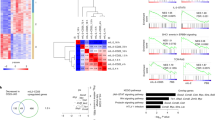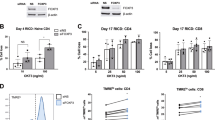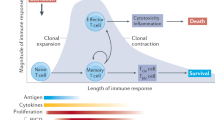Abstract
T cell proliferation is initiated by T cell antigen receptor (TCR) triggering, soluble growth factors or both. In characterizing T cells lacking the septin cytoskeleton, we found that successful cell division has discrete septin-dependent and septin-independent pathways. Septin-deficient T cells failed to complete cytokinesis when prompted by pharmacological activation or cytokines. In contrast, cell division was not dependent on septins when cell-cell contacts, such as those with antigen-presenting cells, provided a niche. This septin-independent pathway was mediated by phosphatidylinositol-3-OH kinase activation through a combination of integrins and costimulatory signals. We were able to differentiate between cytokine- and antigen-driven expansion in vivo and thus show that targeting septins has strong potential to moderate detrimental bystander or homeostatic cytokine-driven proliferation without influencing expansion driven by conventional antigen-presentation.
This is a preview of subscription content, access via your institution
Access options
Subscribe to this journal
Receive 12 print issues and online access
$209.00 per year
only $17.42 per issue
Buy this article
- Purchase on Springer Link
- Instant access to full article PDF
Prices may be subject to local taxes which are calculated during checkout






Similar content being viewed by others
References
Hogquist, K.A. & Jameson, S.C. The self-obsession of T cells: how TCR signaling thresholds affect fate 'decisions' and effector function. Nat. Immunol. 15, 815–823 (2014).
Murali-Krishna, K. et al. In vivo dynamics of anti-viral CD8 T cell responses to different epitopes. An evaluation of bystander activation in primary and secondary responses to viral infection. Adv. Exp. Med. Biol. 452, 123–142 (1998).
Zehn, D., Lee, S.Y. & Bevan, M.J. Complete but curtailed T-cell response to very low-affinity antigen. Nature 458, 211–214 (2009).
Mempel, T.R., Henrickson, S.E. & von Andrian, U.H. T-cell priming by dendritic cells in lymph nodes occurs in three distinct phases. Nature 427, 154–159 (2004).
Miller, M.J., Safrina, O., Parker, I. & Cahalan, M.D. Imaging the single cell dynamics of CD4+ T cell activation by dendritic cells in lymph nodes. J. Exp. Med. 200, 847–856 (2004).
Ehl, S., Hombach, J., Aichele, P., Hengartner, H. & Zinkernagel, R.M. Bystander activation of cytotoxic T cells: studies on the mechanism and evaluation of in vivo significance in a transgenic mouse model. J. Exp. Med. 185, 1241–1251 (1997).
Takada, K. & Jameson, S.C. Naive T cell homeostasis: from awareness of space to a sense of place. Nat. Rev. Immunol. 9, 823–832 (2009).
Chang, J.T. et al. Asymmetric T lymphocyte division in the initiation of adaptive immune responses. Science 315, 1687–1691 (2007).
Nigg, E.A. Mitotic kinases as regulators of cell division and its checkpoints. Nat. Rev. Mol. Cell Biol. 2, 21–32 (2001).
Oh, Y. & Bi, E. Septin structure and function in yeast and beyond. Trends Cell Biol. 21, 141–148 (2011).
Surka, M.C., Tsang, C.W. & Trimble, W.S. The mammalian septin MSF localizes with microtubules and is required for completion of cytokinesis. Mol. Biol. Cell 13, 3532–3545 (2002).
Estey, M.P., Di Ciano-Oliveira, C., Froese, C.D., Bejide, M.T. & Trimble, W.S. Distinct roles of septins in cytokinesis: SEPT9 mediates midbody abscission. J. Cell Biol. 191, 741–749 (2010).
Estey, M.P. et al. Mitotic regulation of SEPT9 protein by cyclin-dependent kinase 1 (Cdk1) and Pin1 protein is important for the completion of cytokinesis. J. Biol. Chem. 288, 30075–30086 (2013).
Kinoshita, M., Field, C.M., Coughlin, M.L., Straight, A.F. & Mitchison, T.J. Self- and actin-templated assembly of mammalian septins. Dev. Cell 3, 791–802 (2002).
Kinoshita, M. Assembly of mammalian septins. J. Biochem. 134, 491–496 (2003).
Rodal, A.A., Kozubowski, L., Goode, B.L., Drubin, D.G. & Hartwig, J.H. Actin and septin ultrastructures at the budding yeast cell cortex. Mol. Biol. Cell 16, 372–384 (2005).
Tooley, A.J. et al. Amoeboid T lymphocytes require the septin cytoskeleton for cortical integrity and persistent motility. Nat. Cell Biol. 11, 17–26 (2009).
Ageta-Ishihara, N. et al. Septins promote dendrite and axon development by negatively regulating microtubule stability via HDAC6-mediated deacetylation. Nat. Commun. 4, 2532 (2013).
Menon, M.B. et al. Genetic deletion of SEPT7 reveals a cell type-specific role of septins in microtubule destabilization for the completion of cytokinesis. PLoS Genet. 10, e1004558 (2014).
Hartwell, L.H. Genetic control of the cell division cycle in yeast. IV. Genes controlling bud emergence and cytokinesis. Exp. Cell Res. 69, 265–276 (1971).
Mostowy, S. & Cossart, P. Septins: the fourth component of the cytoskeleton. Nat. Rev. Mol. Cell Biol. 13, 183–194 (2012).
Gilden, J.K., Peck, S., Chen, M.Y.C. & Krummel, M.F. The septin cytoskeleton facilitates membrane retraction during motility and blebbing. J. Cell Biol. 196, 103–114 (2012).
Joo, E., Surka, M.C. & Trimble, W.S. Mammalian sept2 is required for scaffolding nonmuscle myosin II and its kinases. Dev. Cell 13, 677–690 (2007).
El Amine, N., Kechad, A., Jananji, S. & Hickson, G.R.X. Opposing actions of septins and Sticky on Anillin promote the transition from contractile to midbody ring. J. Cell Biol. 203, 487–504 (2013).
Kechad, A., Jananji, S., Ruella, Y. & Hickson, G.R.X. Anillin acts as a bifunctional linker coordinating midbody ring biogenesis during cytokinesis. Curr. Biol. 22, 197–203 (2012).
Muzumdar, M.D., Tasic, B., Miyamichi, K., Li, L. & Luo, L. A global double-fluorescent Cre reporter mouse. Genesis 45, 593–605 (2007).
Lee, P.P. et al. A critical role for Dnmt1 and DNA methylation in T cell development, function, and survival. Immunity 15, 763–774 (2001).
Cho, J.-H. et al. Unique features of naive CD8+ T cell activation by IL-2. J. Immunol. 191, 5559–5573 (2013).
Bonifaz, L.C. et al. In vivo targeting of antigens to maturing dendritic cells via the DEC-205 receptor improves T cell vaccination. J. Exp. Med. 199, 815–824 (2004).
Surh, C.D. & Sprent, J. Homeostasis of naive and memory T cells. Immunity 29, 848–862 (2008).
Kieper, W.C. & Jameson, S.C. Homeostatic expansion and phenotypic conversion of naïve T cells in response to self peptide–MHC ligands. Proc. Natl. Acad. Sci. USA 96, 13306–13311 (1999).
Sprent, J. & Surh, C.D. Normal T cell homeostasis: the conversion of naive cells into memory-phenotype cells. Nat. Immunol. 12, 478–484 (2011).
Choo, D.K., Murali-Krishna, K., Anita, R. & Ahmed, R. Homeostatic turnover of virus-specific memory CD8 T cells occurs stochastically and is independent of CD4 T cell help. J. Immunol. 185, 3436–3444 (2010).
Wu, Z. et al. Homeostatic proliferation is a barrier to transplantation tolerance. Nat. Med. 10, 87–92 (2004).
Monti, P. & Piemonti, L. Homeostatic T cell proliferation after islet transplantation. Clin. Dev. Immunol. 2013, 217934 (2013).
Khoruts, A. & Fraser, J.M. A causal link between lymphopenia and autoimmunity. Immunol. Lett. 98, 23–31 (2005).
Gattinoni, L. et al. Removal of homeostatic cytokine sinks by lymphodepletion enhances the efficacy of adoptively transferred tumor-specific CD8+ T cells. J. Exp. Med. 202, 907–912 (2005).
Tchao, N.K. & Turka, L.A. Lymphodepletion and homeostatic proliferation: implications for transplantation. Am. J. Transplant. 12, 1079–1090 (2012).
Kitchin, J.E., Pomeranz, M.K., Pak, G., Washenik, K. & Shupack, J.L. Rediscovering mycophenolic acid: a review of its mechanism, side effects, and potential uses. J. Am. Acad. Dermatol. 37, 445–449 (1997).
Stoll, S., Delon, J., Brotz, T.M. & Germain, R.N. Dynamic imaging of T cell-dendritic cell interactions in lymph nodes. Science 296, 1873–1876 (2002).
Barral, Y., Mermall, V., Mooseker, M.S. & Snyder, M. Compartmentalization of the cell cortex by septins is required for maintenance of cell polarity in yeast. Mol. Cell 5, 841–851 (2000).
Caudron, F. & Barral, Y. Septins and the lateral compartmentalization of eukaryotic membranes. Dev. Cell 16, 493–506 (2009).
Saarikangas, J. & Barral, Y. The emerging functions of septins in metazoans. EMBO Rep. 12, 1118–1126 (2011).
Field, S.J. et al. PtdIns(4,5)P2 functions at the cleavage furrow during cytokinesis. Curr. Biol. 15, 1407–1412 (2005).
Janetopoulos, C. & Devreotes, P. Phosphoinositide signaling plays a key role in cytokinesis. J. Cell Biol. 174, 485–490 (2006).
Costello, P.S., Gallagher, M. & Cantrell, D.A. Sustained and dynamic inositol lipid metabolism inside and outside the immunological synapse. Nat. Immunol. 3, 1082–1089 (2002).
Sharma, S. et al. An siRNA screen for NFAT activation identifies septins as coordinators of store-operated Ca2+ entry. Nature 499, 238–242 (2014).
Maléth, J., Choi, S., Muallem, S. & Ahuja, M. Translocation between PI(4,5)P2-poor and PI(4,5)P2-rich microdomains during store depletion determines STIM1 conformation and Orai1 gating. Nat. Commun. 5, 5843 (2014).
Dubois, S., Mariner, J., Waldmann, T.A. & Tagaya, Y. IL-15Pα recycles and presents IL-15 in trans to neighboring cells. Immunity 17, 537–547 (2002).
Gérard, A. et al. Secondary T cell-T cell synaptic interactions drive the differentiation of protective CD8+ T cells. Nat. Immunol. 14, 356–363 (2013).
Hogquist, K.A. et al. T cell receptor antagonist peptides induce positive selection. Cell 76, 17–27 (1994).
Ihara, M. et al. Cortical organization by the septin cytoskeleton is essential for structural and mechanical integrity of mammalian spermatozoa. Dev. Cell 8, 343–352 (2005).
Acknowledgements
We thank the Biological Imaging Development Center personnel (UCSF) for technical assistance with imaging, J. Roose and O. Ksionda (UCSF) for reagents and helpful discussion, E. Palmer (University Hospital Basel and University of Basel) and D. Zehn (Swiss Vaccine Research Institute and Lausanne University Hospital) for reagents, and M. Kuhns (University of Arizona College of Medicine) for critical reading of the manuscript. Supported by the US National Institutes of Health (R01AI52116 to (M.F.K).
Author information
Authors and Affiliations
Contributions
A.M.M. and M.F.K. designed the experiments for all primary text figures; A.M.M. did experiments; J.K.G. performed and helped with experiments related to initial characterization of Sept7cKO mice; A.G. contributed to experimental design and analysis; M.K. provided the Sept7flox/flox mice and consulted on experiments; A.M.M. and M.F.K. wrote and revised the manuscript.
Corresponding author
Ethics declarations
Competing interests
The authors declare no competing financial interests.
Integrated supplementary information
Supplementary Figure 1 Septin-deficient T cells develop similarly to wild-type T cells.
(a) Intracellular Septin 7 protein expression by polyclonal CD4+ and CD8+ T cells from Sept7cKO or control mouse spleen as assessed by flow cytometry. (b) Protein levels of septin family members determined by Western blots of isolated CD8+ T cells from Sept7cKO or control OT-I mouse spleens. (c, d) Intracellular septin 7 expression (c) and frequency (d) of thymocyte populations from the thymus of Sept7cKO or control mice. (e, f) Cellularity of secondary lymphoid organs (e) and frequency of peripheral lymphocytes in lymph nodes (f) of Sept7cKO or control mice. (g) Intracellular phalloidin levels of naïve polyclonal CD8+ Sept7cKO or control T cells as tested with flow cytometry. (h, i) Activated Sept7cKO and control OT-I cells were plated on ICAM-1-coated coverslips and imaged for morphological measurements. Images of control and Sept7cKO cells illustrating the elongated uropod of Sept7cKO cells (h). Quantification of measurements and population distribution of cell length (i). Data is representative of two (h, i), three (a-c, e), or five (d, f) independent experiments. Small horizontal bars denote the SEM. *P <0.05 with data analyzed with unpaired t-test (e).
Supplementary Figure 2 Septin-deficient CD8+ T cell multinucleated cell formation is associated with an increase in size, despite similar initial F-actin levels and normal activation.
(a-f) Sept7cKO or control CD8+ OT-I T cells were cultured in vitro with SL8-pulsed (100ng/ml) BMDCs, on plate-bound anti-CD3 or anti-TCR with soluble anti-CD28, or with PMA and ionomycin. Quantification of mean CFSE dilution peak number of live activated Sept7cKO and control OT-I cells 72h after a designated in vitro condition (a). Frequency of live CD8+ cells from Sept7cKO or control OT-I mice with a given DNA content level as assessed by Hoechst with flow cytometry 72h following in vitro activation (b). Comparison of cellular forward-scatter area and intracellular Septin 7 within activated CD8+ T cells isolated from Sept7cKO OT-I lymph nodes 72h after in vitro activation. Gating delineates a population of septin-competent T cells in Sept7cKO mice (c). F-actin levels in Sept7cKO and control CD8+ OT-I T cells 24h following in vitro activation (d). Cell surface CD69 (e) and CD25 (f) expressed by CD8+ OT-I T cells 24h after activation. (g) Calcium flux in isolated naïve CD8+ OT-I T cells following stimulation by anti-CD3 clustering (top) or thapsigargin stimulation (bottom). The average of technical duplicate or triplicate samples for a given experiment and condition was calculated and graphed (a, b). Data is pooled from at three (a), six (b, right), seven (b, middle), or ten (b, left) independent experiments, or representative of three independent experiments (c-g). Small horizontal bars denote the SEM. *P <0.05, **P<0.01, ***P< 0.001, ****P< 0.0001 with data analyzed with unpaired t-test (a, b).
Supplementary Figure 3 Septin-null T cell division is enhanced by costimulatory but not cytokine signaling.
(a-d) Sept7cKO and control OT-I T cells were stimulated in vitro and the mean CFSE peak number of live cells was quantified. Analysis of cell proliferation 5d after exposure in vitro to IL-7 (5ng/ml) and IL-15 (100ng/ml), or IL-2 (5000U/ml) (a), 72h after PMA/iono or anti-TCR activation with or without the presence of low-dose IL-2 (10-20U/ml) (b), 72h after PMA/iono activation in the presence of plate-bound Fc-ICAM, fibronectin, anti-CD44, or anti-CD28 (c), or 48h following PMA/iono stimulation in conjunction with plate-bound Fc-ICAM for a designated temporal duration (d). The average of technical duplicate or triplicate samples was calculated and graphed. Small horizontal bars represent the SEM. Data is pooled from three (a, b) or four (c, d) independent experiments. *P< 0.05, **<P 0.01, ***P< 0.001 with data analyzed with unpaired (a, c), or paired (b) t-test, or a matched one-way ANOVA test with Fisher’s LSD post-test (d).
Supplementary Figure 4 BMDCs mediate septin-deficient T cell division through PI(3)K costimulatory signaling.
(a-e) Sept7cKO (red) and control (black) OT-I live activated cell mean CFSE dilution peak number was calculated following in vitro activation. Quantification of T cell CFSE dilution 72h following PMA/iono activation with addition of antigen-free or SL8-pulsed (100ng/ml) BMDCs, or supernatant from BMDC-T cell culture (a), 72h following PMA/iono activation with addition of antigen-free BMDCs and designated blocking antibody 0h (left) or 24h (right) after plating (b), 72h following PMA/iono activation with addition of antigen-free BMDCs and PI(3)K inhibitor LY294,002 (10μM) (left) or GDC-0941 (10μM) (right) (c), or 72h following activation with SL8-pulsed (1-100ng/ml) BMDCs with addition of PI(3)K inhibitor LY244,022 (10μM) or GDC-0941 (10μM) 36h (d) or 24h (e) after plating. The average of technical duplicate samples was calculated and graphed. Small horizontal bars denote the SEM. Data is pooled from three (a, d, e), five (b, c, left), or six (c, right) independent experiments. *P< 0.05, **<P 0.01, ***P< 0.001, ****P <0.0001 with data analyzed with an unmatched one-way ANOVA test with Fisher’s LSD post-test.
Supplementary Figure 5 LPS-treated B cells enhance septin-null CD8+ T cell division through costimulatory PI(3)K signaling.
(a) Cell surface expression of CD69 by Sept7cKO or control CD8+ OT-I T cells following 24h of co-culture with SL8-pulsed (100ng/ml) resting or LPS-treated B cells. (b) Quantification of Sept7cKO and control OT-I live cell mean CFSE peak number 72h following in vitro co-culture with resting or LPS-treated B cells and addition of blocking antibodies against CD80, CD86, and/or LFA-1, or PI(3)K inhibitor LY294,002 (10μM). The average of technical duplicate samples was calculated and graphed. Small horizontal bars denote the SEM. (c) CFSE dilution of Sept7cKO or control CD8+ OT-I T cells 72h after in vitro activation by resting or LPS-treated B cells and addition of denoted blocking antibodies, or PI(3)K inhibitor LY294,002 (10μM). Data is representative of three (a, b, right), or four (b, left) experiments. *P< 0.05, **P< 0.01, ***P< 0.001, ****P <0.0001 with data analyzed with an unmatched one-way ANOVA test with Fisher’s LSD post-test (b).
Supplementary Figure 6 Homeostatic maintenance of septin-deficient and control CD8+ memory T cells in the lymph node.
(a-c) Sept7cKO and control OT-I T cells were transferred to DecOVA-immunized mice, sorted from the spleen and lymph nodes 14d later, and co-transferred to antigen-free host mice. Ratio of control to Sept7cKO OT-I T cells sorted from lymph nodes 14d post-DecOVA immunization. *P value = 0.0107 with data analyzed with 1-sample t-test comparing distribution to theoretical mean of 1 (a). Surface expression of CD44 and CD62L on Sept7cKO and control OT-I T cells sorted from pooled spleen and lymph nodes 14d post-DecOVA immunization (b). Ratio of control to Sept7cKO OT-I T cells recovered from pooled skin-draining lymph nodes 8 weeks following co-transfer to antigen-free hosts. Non-significant P value (> 0.05) with data analyzed with 1-sample t-test comparing distribution to theoretical mean of 1 (c). Each symbol represents an individual experiment (a) or mouse (c). Small horizontal lines demarcate the SEM. Data is pooled from four (c) or five (a) independent experiments with total n = 5 (a) or 6 (c), or representative of two independent experiments (b).
Supplementary information
Supplementary Text and Figures
Supplementary Figures 1–6 (PDF 1365 kb)
Rights and permissions
About this article
Cite this article
Mujal, A., Gilden, J., Gérard, A. et al. A septin requirement differentiates autonomous and contact-facilitated T cell proliferation. Nat Immunol 17, 315–322 (2016). https://doi.org/10.1038/ni.3330
Received:
Accepted:
Published:
Issue Date:
DOI: https://doi.org/10.1038/ni.3330
This article is cited by
-
In vivo imaging of the immune response upon systemic RNA cancer vaccination by FDG-PET
EJNMMI Research (2018)



